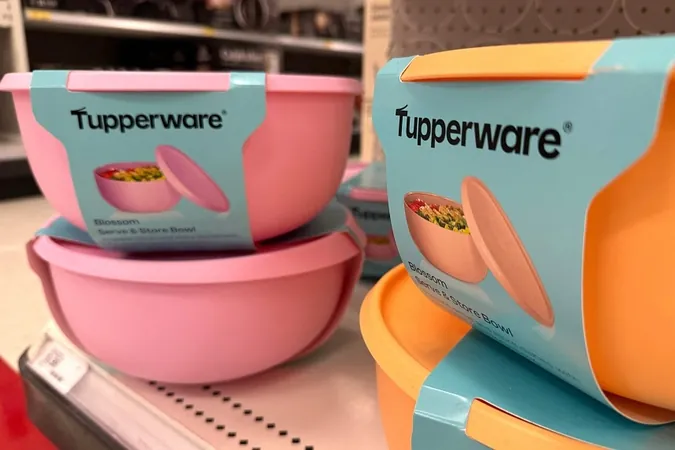
Tupperware Faces Troubling Times: A Billion-Dollar Battle for Brand Value in Bankruptcy Court
2024-09-18
Introduction
WASHINGTON – Once a household name synonymous with food storage, Tupperware is now at a crossroads as it enters bankruptcy proceedings amidst a fierce fight over its valuable assets, including its iconic brand name. On September 17, Tupperware Brands filed for Chapter 11 protection in Wilmington, Delaware, signifying a desperate attempt to restructure while still operating.
Current Financial Struggles
The company, burdened with debts nearing $800 million, finds itself amidst a tug-of-war between lenders, who are deadlocked over the course of action—whether to work on a restructuring plan or to simply foreclose on the brand, its inventory, and other vital assets. The atmosphere is charged, with distressed-debt investors like Stonehill Institutional Partners and Alden Global Capital vying for control.
Market Dynamics
Despite Tupperware’s long-standing history, the company's struggles have risen to the surface in bankruptcy court. According to Chief Restructuring Officer Brian Fox, Tupperware's pressing liquidity needs prompted a renewed marketing effort, but these initiatives have had minimal impact against the backdrop of a rapidly changing retail environment.
Declining Sales and Shift in Model
The company’s woes have been ongoing for nearly a decade. The traditional model of independent representatives hosting 'Tupperware parties' has dwindled, overshadowed by the proliferation of cheaper online alternatives and shifting consumer preferences. Though there was a brief surge in sales during the COVID-19 pandemic as people cooked more and sought storage solutions, this uplift did little to rectify the decline.
Meme-Stock Frenzy
This year, Tupperware experienced a fleeting moment of optimism amid the meme-stock frenzy, where its shares unexpectedly soared, igniting hope among investors. However, the core issues of declining sales remained unresolved, pushing the company into bankruptcy.
Bankruptcy Filings
The bankruptcy filings reveal exhaustive attempts to salvage the company, including a controversial decision to lift trading restrictions on its debt. This move drew new investors who scooped up significant portions of Tupperware’s senior loans for just a fraction of their worth, leading to legal battles over perceived exclusions from lucrative debt offers.
Negotiations with Lenders
In the face of looming decisions, Tupperware initiated negotiations with lenders about selling its assets, including its cherished brand name. However, disagreements arose regarding the company's path forward—whether to opt for a straightforward foreclosure or a complex restructuring in court, with the latter seen as a strategy to shield executives from legal repercussions.
Difficult Decisions
The lenders pressured Tupperware to avoid bankruptcy, arguing that a Chapter 11 filing would unfairly limit their recovery while diminishing the prospects of other creditors. Conversely, Tupperware claimed that a foreclosure would unjustly eliminate opportunities for lesser-ranked creditors to claim a payout.
Decision to Pursue Bankruptcy
In a decisive maneuver, Tupperware chose to pursue bankruptcy protection, disregarding the lenders’ warnings of a fierce opposition to a Chapter 11 approach, thereby igniting tensions.
The Historical Context
To understand Tupperware’s decline, it’s essential to reflect on its rich history. Founded in 1946 by Earl Tupper, the company revolutionized food storage with its patented airtight seal, quickly becoming a staple in American households through the nationwide Tupperware party concept. However, as competition has intensified and consumer preferences evolved, the brand has struggled to maintain its relevance.
Future Considerations
By 2023, Tupperware's reliance on a network of approximately 465,000 independent vendors and 5,450 employees became a burden. Consumers increasingly turned to online shopping on platforms like Amazon and Walmart for similar—and often cheaper—alternatives, including more sustainable packaging options.
Operational Changes
With financial pressures mounting, the company has considered closing its only U.S. factory and laying off about 150 employees. Current attempts to find a buyer show that the highest offer received barely covers 20% of Tupperware’s outstanding debts.
Aiming for the Future
In a statement upon filing for bankruptcy, Tupperware’s President and CEO Laurie Ann Goldman stressed that this process would provide much-needed flexibility as the brand aims to transform into a digital-first enterprise, better prepared to meet the evolving needs of its consumers and stakeholders.
Conclusion
As Tupperware navigates these turbulent waters, the battle for its future—and the fate of a once beloved brand—remains precarious. The outcome of the ongoing bankruptcy proceedings will ultimately determine whether Tupperware can reinvent itself or if it will become yet another casualty of changing times in the retail industry.


 Brasil (PT)
Brasil (PT)
 Canada (EN)
Canada (EN)
 Chile (ES)
Chile (ES)
 España (ES)
España (ES)
 France (FR)
France (FR)
 Hong Kong (EN)
Hong Kong (EN)
 Italia (IT)
Italia (IT)
 日本 (JA)
日本 (JA)
 Magyarország (HU)
Magyarország (HU)
 Norge (NO)
Norge (NO)
 Polska (PL)
Polska (PL)
 Schweiz (DE)
Schweiz (DE)
 Singapore (EN)
Singapore (EN)
 Sverige (SV)
Sverige (SV)
 Suomi (FI)
Suomi (FI)
 Türkiye (TR)
Türkiye (TR)